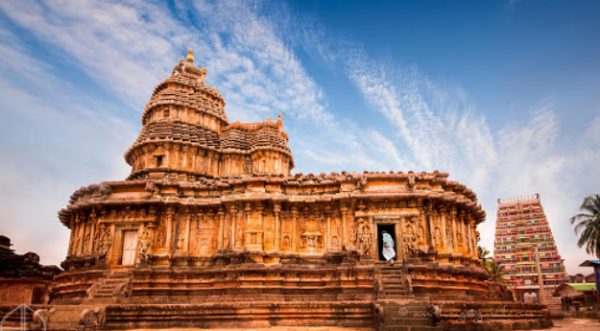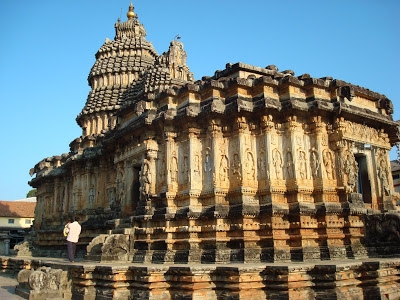Vidyashankar, the Zodiac temple in Sringeri
The Vidyashankara Temple at Sringeri is a magnificent piece of architecture and is built entirely out of carved stone, in 1338 A.D. by Vidyaranya
Total Views |
Zodiac signs are a topic which many take interest in and each sign has something unique about it, influencing our life. It is really interesting to get to know our personality traits and our future according to our zodiac signs. What is also as fascinating is a temple having 12 pillars that correspond to zodiac signs, and are constructed in such a way that the sun’s rays fall on each pillar in the exact order of the 12 months of the Hindu calendar! Let’s get to know more about this temple:


History | The Vidyashankara Temple at Sringeri is a magnificent piece of architecture and is built entirely out of carved stone The temple was built in circa 1338 A.D. by Vidyaranya in memory of his Guru Vidyashankara / Vidyathirtha with the support of Vijayanagara rulers. Vidyaranya was the head of Sringeri Sharada Peetham from 1331 AD - 1386 AD, who played a key role to establish the Vijayanagara Empire against the Muslim invaders from North India.
The Sringeri Sharada Peetham, adjacent to Vidyashankara temple, was first established by Adi Shankaracharya in the 8th century and had installed a sandalwood idol of Goddess Sharada along with a Sri Chakra in front of her. Later, due to destruction by Muslim invaders, this broken idol was replaced with a Gold Idol of Goddess Sharada by Vijayanagara Rulers.
The Sringeri Sharada Peetham, adjacent to Vidyashankara temple, was first established by Adi Shankaracharya in the 8th century and had installed a sandalwood idol of Goddess Sharada along with a Sri Chakra in front of her. Later, due to destruction by Muslim invaders, this broken idol was replaced with a Gold Idol of Goddess Sharada by Vijayanagara Rulers.
Sri Vidyashankara Temple: A marvel of Vedic architecture.
— Ashish Jaggi (@AshishJaggi) July 12, 2020
12 pillars surrounds the Mandapa (eastern half of the structure)with 12 figures of the zodiac sign.
They are constructed in such an ingenious way that the rays of the sun fall on each pillar in the 1/5#IndicAwakening pic.twitter.com/7KEu7qVxah
Architecture | The Vidyashankara temple built on samadhi of Vidyashankara is an admirable monument made entirely of carved stone - like the architectural style of Hoysalas & Dravidians. The temple structure is on a high plinth featuring sculptures of the Hindu gods and many scenes of Hindu mythology covering the outer wall.
The back side of the temple has sculptures of Lord Vishnu’s incarnations - the Dashavataras. The Vijayanagara Emperors influenced by Vidyaranya, have made great contributions to the temple structures.
The back side of the temple has sculptures of Lord Vishnu’s incarnations - the Dashavataras. The Vijayanagara Emperors influenced by Vidyaranya, have made great contributions to the temple structures.
Also Read | Shore temple, that emerged from the sea: A brief history
There are 6 doorways leading to the temple, & 12 intricately carved pillars known as Zodiac / Raashi pillars in the temple hall. Every pillar has a roaring lion with a rolling stone ball in its mouth. The pillars marked with their corresponding Zodiac sign are arranged in such so that the sun’s rays fall on the pillar in order of the 12 solar months. For example, if the Sun is now located in the constellation Capricorn, then the rays fall on the pillar with the Capricorn symbol.

A huge elevated circle is marked with converging lines on the flooring, indicating the direction of the shadows from the zodiac pillar. Entering the temple from the west side, the main sanctum has Vidya Ganapathy on one side, and Goddess Durga on the other. Shrines of Brahma, Vishnu & Maheshwara with their consorts house in the main sanctum. Lord Shiva’s idol is installed on the Samadhi facing towards East.
The temple’s unique style belongs dominantly to the Hoysala era. But the temple has curved sides like the temples in Kerala, or like the Chalukyan Durga temple in Aihole.
The temple’s unique style belongs dominantly to the Hoysala era. But the temple has curved sides like the temples in Kerala, or like the Chalukyan Durga temple in Aihole.
Also Read | Kandariya Mahadeva Temple: The architectural pride of Khajuraho!
The top of the temple combines the different designs together. The walls here will remind you of temples at the World Heritage site of Hampi - the capital city of the Vijayanagara Empire. It is a unique blend of different styles of India – South Indian temple architecture to be more specific, which probably isn’t found anywhere else.
On the carved ceiling one can witness exceptional craftsmanship, which is also usually found in Hoysala & Vijayanagar styled temples. This temple lies on the banks of Tungabhadra River. A lot of fish can be seen on the river edge, where the devotees feed them puffed rice. They are believed to be sacred fish & are not supposed to be caught.


